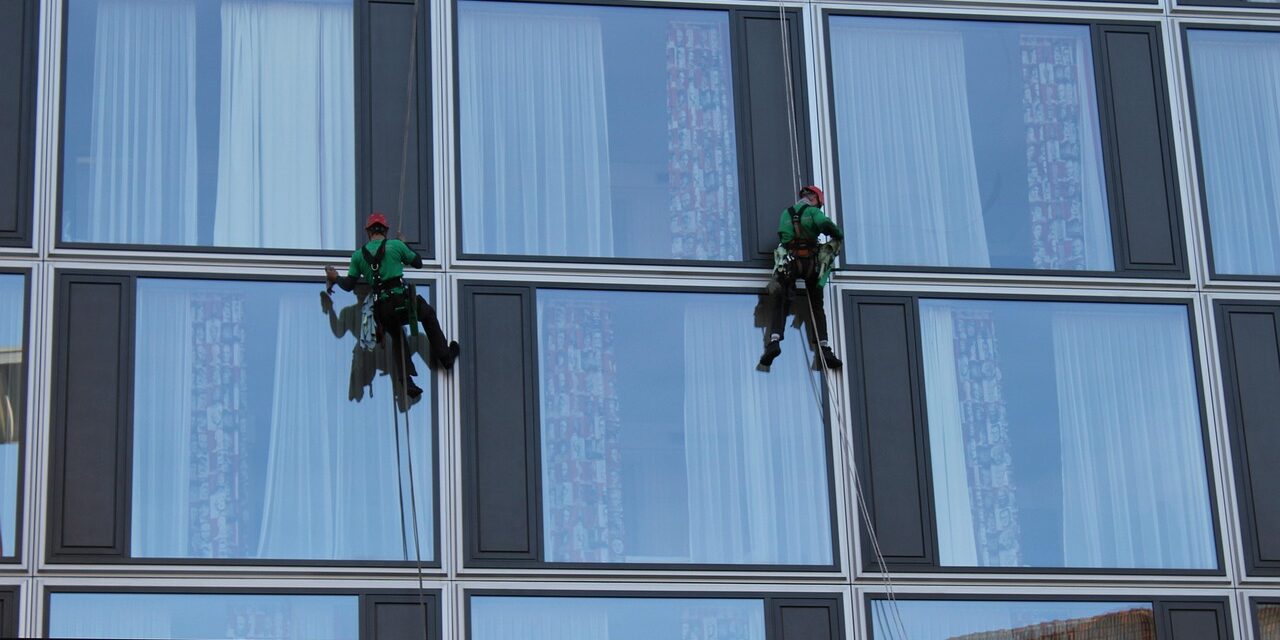Window cleaning might seem simple enough, but it comes with its fair share of risks, especially when you’re reaching for a tricky spot halfway up a ladder.
One small slip, and what started as a simple chore could end in a bruised ego, or worse.
Whether you’re working on upper floors or tackling streaks at ground level, a little caution goes a long way. So, before you grab that cloth, take heed of the following safety tips. They can save you a lot of pain later.
Choose the Right Supplies
You don’t need a full arsenal to clean your windows—a few solid tools will do the trick.
First and foremost, you’ll need a sturdy ladder with a rubber base to hold you steady. Resist the urge to balance on a chair, table, or any other makeshift platform. These DIY setups may seem convenient, but they’re an accident waiting to happen.
To avoid the need to stretch precariously a few feet off the ground, grab a long-handled squeegee.
Microfibre cloths and a good-quality glass cleaner will also make the process a lot faster, reducing the time you spend up there. However, not any cleaner will do. Many popular name brands contain harsh chemicals that can be rough on your skin and lungs.
To be on the safe side, go for those labelled ‘non-toxic’ or ‘eco-friendly’. These gentler options are just as effective on grime but much kinder to both you and the planet.
In any case, when using store-bought products, it pays to check the label for safety instructions and keep the room well-ventilated.
And don’t forget the goggles and gloves. They’re not exactly a fashion statement, but they’ll save you from itchy hands and stinging eyes later.
Inspect Your Surroundings Carefully
Before you get started, take a good look at your surroundings. Uneven surfaces, wet spots, or stray obstacles can all cause you to slip or lose your balance.
If the ladder wobbles, so will you. So, tighten the bolts for good measure, clear away any clutter, and move the cables out of the way.
And if you’re cleaning exterior windows, check for anything that might move underfoot, like loose gravel or a sneaky garden hose.
Those small puddles or uneven pavers can be more treacherous than they look. Unless you’re willing to pay the A&E a surprise visit, make sure the ground is dry and level before setting up.
Eliminate the Risk of Falls and Slips
Soapy water and hard floors are a dangerous combination. Even after inspecting your work area carefully, the floor can get wet accidentally while you’re blissfully wiping away, completely unaware.
To eliminate any chances of slipping, make sure you’re wearing sturdy shoes with a good grip, and mop up any puddles that form as you go.
If you’re working on a ladder, give the soles of your shoes a quick wipe before climbing again. Otherwise, the rungs may turn into a mini slip ‘n’ slide.
If you’d rather avoid the hassle altogether and don’t mind doing a little extra cleaning later, place a non-slip mat underneath to catch any drips.
And if you’re working outside, check the weather forecast beforehand and schedule this task on a clear, dry day. If rain decides to drop by unannounced or the wind suddenly starts to pick up, you’re better off packing up and trying another day.
Be Extra Mindful of Your Position
Ladders may be easy to use, but they do demand a little respect. To maintain your balance, always keep three points of contact on the rungs—two feet and one hand, or vice versa.
Next, check the angle. Your ladder should rest at about 75 degrees. That’s the sweet spot for optimal stability—too steep, and it might tip backwards; too flat, and it could slip out from under you.
A quick way to check is to stand at the base and stretch out your arms. If your palms touch a rung comfortably, then you’re good to go.
Once you’re up, resist the urge to lean too far to one side. Unless you’re willing to explain to your neighbour how you ended up in their rose bush, it’s best to climb down and move the ladder.
When you reach those awkward corners, rely on extendable tools instead of twisting yourself into knots, and always keep your back straight.
It’s tempting to tackle this chore in one go, but window cleaning can be surprisingly demanding, especially for bigger homes.
Fatigue often leads to mistakes, and mistakes can lead to broken bones. So, pace yourself and take regular breaks to stretch your muscles.
Enlist Some Help
When working on a ladder, it’s always wise to have someone nearby. Whether it’s a neighbour or family member, a second pair of eyes reduces the risk of accidents.
They can hold the base steady, hand you tools, or shout helpful directions like “a little to the left!” if your view is restricted. And in case something goes wrong, you’ll have someone ready to help—or at least call for it.
If no one is available to spot you, it might be time to type window cleaners near me into that search bar. Professional cleaners have the equipment, training, and confidence to tackle windows at any height safely and efficiently.
Plus, an experienced crew will have a better understanding of your area’s conditions, whether that’s coastal salt, pollen, or city dust. They’ll know exactly how to deal with the kind of grime your windows face most often, leaving the glass spotless without a single streak.
And the best part? You get to stay safely on solid ground, perhaps with a nice cuppa in hand, while they brave the heights for you.
Conclusion
Window cleaning shouldn’t feel like an extreme sport. With careful planning, the right tools, and a healthy respect for safety, you can get that sparkling finish without any scrapes or scars.
Take your time, stay steady, and know your limits. If it feels too risky, it’s always wiser to call in the pros. After all, a clear view is far more enjoyable when you’re not nursing a sprained ankle—or worse.


















